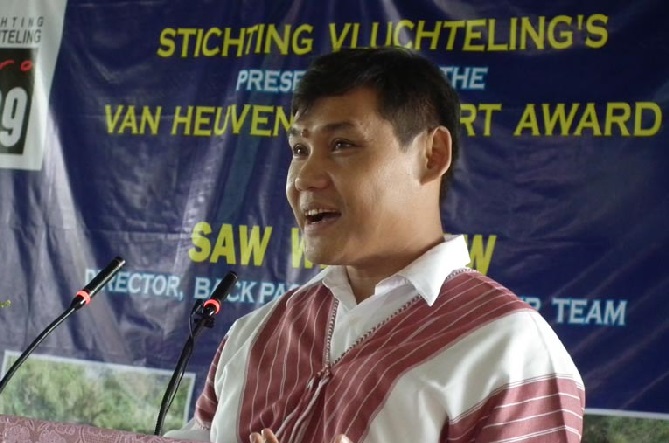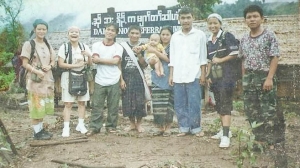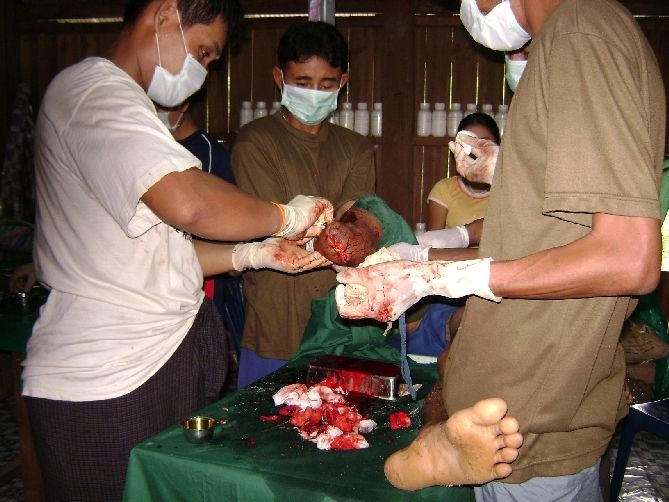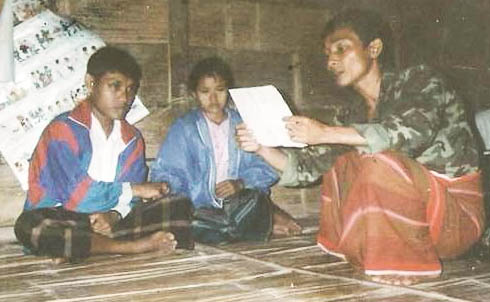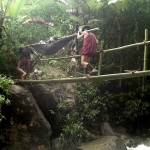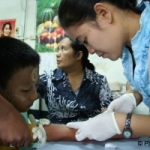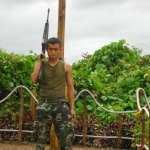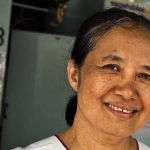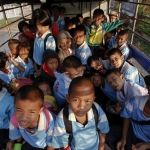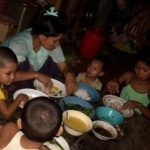Burma Link | March 14, 2014
Saw Win Kyaw is a 42-year-old Buddhist Karen man who was born and grew up in Hpa-an Township. Taking to the streets in the 8888 uprising, 17-year-old Saw Win Kyaw and thousands of other students were forced to flee to the jungle after the military took over power. Saw Win Kyaw trained as a medic and in 1995, helped to establish a bamboo hut clinic in the war-torn jungles of northern Karen State. He ran the clinic for over a decade, delivering babies in emergency conditions with no experience, amputating more than 150 limbs with extremely limited equipment, and training hundreds of others in an attempt to promote a community-based health system in an area where health services were completely destroyed. From Burmese army attacks to the threat of landmines and malaria, for Saw Win Kyaw and other jungle medics, these are nothing but ‘normal conditions’. In 1998, Saw Win Kyaw joined the Back Pack team and soon after became the field-in-charge for Papun area. He is now the director of the organisation and manages over 300 health workers across rural ethnic areas in Burma. In 2012, Saw Win Kyaw received an international award, the Van Heuven Goedhart Award, for his merits as a special health worker. This story depicts his life and experiences in the jungle and beyond. What was it like to perform an amputation for the first time? What were the main challenges and difficulties he and his team faced in the jungle? How did he get to where he is today and what are the current challenges cross-border aid workers are facing in changing Burma? This is his story.
Growing up in Hpa-an: “Most people were very angry at the government”
I was born in Hpa-an, the capital of Karen State. I lived in downtown Hpa-an because my parents were school teachers. I lived there until I was 17 years old. At the time in Hpa-an, they took tax for porter fees. When the Burmese military troops are going to the front lines, porters carry military materials for them. So they arrested a lot of porters: In the cinemas, in the harbour, sometimes they arrested porters in the house. So at night time most men fled to the jungle and they were sleeping and living in the jungle. Even my father and my old brother, although they were government staff, they were also arrested in the same way. We also had to pay a lot for porter fees every week. So the situation and the conditions were very bad.
At the time they
8888 Uprising: “The whole country, especially students, left to the jungle”
At the time I was 17 years old. I attended school in Hpa-an, I was a high school student on 9th standard. And then in 1988 the student uprising swept through all of Burma. We heard about what happened in Yangon. There was a technological engineering student and a student demonstration in Yangon Institute of Technology. And they broke it down with guns.
I also took part in the uprising and the demonstration. My parents were also very angry and joined the demonstration. We went to the streets in Hpa-an. There were a lot of people. Even most people living in rural areas came to Hpa-an and they demonstrated a lot. Then Ne Win and the government… The military took power. They announced everywhere in our Hpa-an that the people who are in demonstration sites have to move to other places. If not they will shoot. At the time in Hpa-an they [Burma Army] had one Brigade and four or five Battalions. Most people knew that and they were afraid of the military. Most people left Hpa-an. Many many students and many many villagers and civilians moved to the jungle. The whole country, especially students, left to the jungle, the Karen revolution area, the KNU controlled area.
I also left. I left from Hpa-an with my two colleagues (fellow students). Later I heard that one of them moved to Malaysia and robbed a gold shop with a Chinese guy. And Malaysia police shot them dead. The other one has been resettled to the US now.
From Manerplaw to Papun: “The health program and health activity are totally dead, destroyed”
After the military government took over power, I fled to the jungle and then I arrived Manerplaw. In 1989 I attended basic medical training in a KNU hospital in Manerplaw for six months. I took take care of the patients and worked as a health worker in that area and also in some Karen communities. Then from 1992 to 1996 I attended war casualty management training course, a three year training course. Trainers from Norway, two doctors, they trained us mainly in how to take care of injured patients.
In 1994, Manerplaw fell down. It was 1994 December and 1995 January. At the time DKBA and KNU were divided and fighting. The military government helped DKBA, and KNU’s headquarters Manerplaw fell down. At the time I was working in the Manerplaw base hospital. Most people fled and I also fled to Mae Rah Moe refugee camp together with refugees. I lived there for one or two months because I had to take care of patients in the camp with some medical leaders. One or two months after AMI [Aide Médicale Internationale] arrived there and they set up their hospital and clinic.
Then one of my colleagues said: The AMI also is here now and provides a health program. So there is no need for special health care here. We should help our area (our native Karen State), we should help them. Because currently the health program and health activity are totally dead, destroyed. If you arrive there you can help. At least you can help the injured patients. In the current situation they are still fighting a lot and you can help there. He called me and I was so interested. So I moved to Papun area.
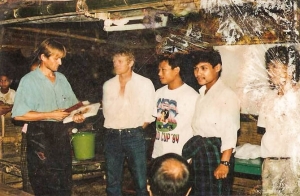
War Casualties Management Training Diploma Course (93-96), in Karen State (Jungle University) with two MD Trainers from Norway. (Photo: Saw Win Kyaw)
Setting up a jungle clinic: “If we had some medicine then we gave medicine”
After Manerplaw fell to the military government I moved to Papun area. At the time there was a big government military offensive and health and education sector in that area was totally destroyed. That’s why I tried to set up one small clinic in the northern Papun area, we call it Dae Bu Noh clinic.
I arrived to Papun on May 15 in 1995. At the time I had nothing. At the time we didn’t know, we never heard about any NGO, INGO or international organisations. I discussed with some health workers, my colleagues, with some medics. We discussed that we should set up a small clinic here. But only a bamboo clinic. So we tried to do as much as we can and we set up [the clinic]… We tried to help and take care of the health of the community as much as we could.
But I had only attended basic medical training and how to take care of injured patients. So I faced a lot of problems with other diseases like complicated malaria. Yes I was very bad at taking care of common diseases like pneumonia and also typhoid. Those cases were very difficult for me. Also the delivery cases and taking care of pregnant women were very difficult. At the time I had very little knowledge in how to take care of pregnant women.
In the beginning we had nothing. If we saw a patient we had a look and we tried to take care. And if we had some medicine then we gave medicine, if not we suggested to the patient’s family that they purchase some medicine. For the medicine, we asked the local leaders and we asked our health leaders… At the time Dr. Cynthia Maung’s Mae Tao Clinic also had one team there. I went there and I asked medicine from them. Later on Dr. Cynthia Maung heard about the clinic and she sent us some medicine. And then here we worked together with the Karen Department of Health and Welfare and they also started sending medicine. Later on we could do it, we could provide medicine.
The first delivery: “I did CPR for more than 45 minutes”
There is one experience I had in that area. It was my first delivery case.
One villager called me and he said that my wife is pregnant and started having contractions and abdominal pain. He called me and he said that please try to do delivery for my wife. I replied that it is not my expertise, I can’t do it. He said that in this area you are the higher level of health department. So at least you can help with something. I was so scared and afraid at the time, because I can’t do it. I had seen others, like our teachers and some staff do delivery but I had never done it myself. So it was very difficult for me…
This delivery was prolonged labour, meaning it took a very long time. And people suggested that I should abort the baby to save the mother’s life. I was so scared and I discussed with the woman, the mother. She said that I’m getting old. I want children, a baby. That’s why I don’t want to abort my child. If the child dies I will die together with the child, she said. At the time she was 32 or 34 years old, and I was 24 years old. So I compromised with her.
I thought that in Manerplaw clinic I saw that they gave some medicine to have more contractions. I asked about that medicine, oxytocin, but at the time we couldn’t get it in our area. Eventually I found the contraction medicine in that area and luckily within three or four hours, there were some more contractions. Somebody was also pushing a little bit, and that baby… we could see the head. But the mother was unconscious. I thought that in my experience in the Manerplaw clinic, we should hold on to the child. I told one traditional birth attendant you should hold on to the child’s mouth. I told him and he did it. Luckily, that baby came out.
Then… I looked and that baby was coming out but he was very silent. So I cut the umbilical cord and for the mother I had already given some medicine. Then I did CPR for more than 45 minutes. Luckily that baby, that child was also alive. He is very lucky. And the mother… In the next two or three hours, she woke up.
Until this day, they are alive. Very lucky.
That was my first experience and I was so scared and afraid. After that I faced a lot of delivery cases in that area. That’s why I came to Mae Tao Clinic and I asked Dr. Cynthia Maung: Dr. Cynthia, thramu, you should teach us how to do delivery, how to take care of the pregnancy delivery case? She trained us for one month. We were very lucky. Later when I was faced with those cases I could manage.
Burning the clinic: “I want one thing; a bone saw!”
In 1997, the military government burned down our clinic. Not only my clinic, they burnt the whole village and also the Toe They Del clinic, which is supported by Dr. Cynthia Maung.
The villagers knew that if the military troops come they need to flee to the jungle. So the troops arrived in the village and they burnt down the village. Then they also came to our clinic and they burnt it down.
We knew they were coming. We fled together with six landmine injury patients. We had to carry them. We were far away but we saw the clinic burning. Our clinic is close by Yoon Sa Linn river, a small river. We were living on another mountain and we could see far away. We saw [the clinic burning]. It took one week, we lived in the jungle for a week. And we tried to set up the clinic again.
Some material we could bring with us but some material we lost. That’s why at the time I asked one of my health leaders: I have lost my bone saw, can you help me? He had just arrived in Bangkok and he met with one Australian doctor, Dr. Kate, an advisory for Mae Tao Clinic. We met Dr. Kate during the Christmas month and she asked: Do you want any present for Christmas? I say yes I want one thing; a bone saw! She sent two bone saws for us.
Landmine injuries: “Our staff had never experienced how to do amputation”
Especially in 1997 and 1998 until 2000 there was a big offensive in our area and a lot of patients. Some were KNU/KNLA soldiers and some came not only from Papun district but also from Thaton, Nyaung Lay Bin and Taungoo district. And Karenni, they also came.
I did around 150 amputations in Papun area. The first time, I saw a patient with landmine injury and I brought him back to my clinic. At the time I was not experienced doing amputation for a human. So I wanted to refer him to a Thai clinic or Thai hospital. At the time there was a lot of fighting and the local authority, local commander, he did not allow to send the patient to Thailand. He did not allow because of the fighting it would be more dangerous than for us to take care of him in my clinic. He said that if you refer your patient you have to have at least 10 or 12 persons carrying the patient. And if there is fighting and both sides shoot, it is more dangerous than if you take care of him in your clinic. So I decided… It was very difficult for me, but I decided I need to do amputation in my clinic.
At the time we had no blood bags, blood transfusion bags and also our staff had never experienced how to do amputation. I knew because I attended the war casualty management training course. But at the time I did it only with a pig, not human.
I tried to do it. First we gave the anesthesia. That was also difficult for me. And I organised one team and I tried to use tourniquet to stop the bleeding. My colleague used a very small piece of the tourniquet, just only three inches. He tied the thigh and I cut the thigh and then… In the thigh they have the femoral artery. The femoral artery, that is so big, so big… And I told him that it’s still oozing and bleeding so you should more tightly, I ordered him and he tried to tie again and the tourniquet broke. It was bleeding a lot. I was so afraid and I took some cloth and I pressed that bleeding point. Then I tied it with some thread and I could stop the bleeding. I could save the amputated leg.
Currently he is still alive.
At the time we had no surgeon in that area and most injured patients were sent to my clinic and to me. I tried to find a lot of blood bags, blood transfusion sets and also medicine. Some medicine was sent to me directly by my top staff.
In my hands one injured patient, landmine patient, died. Because at the time I had not enough blood bags. Most landmine injury patients are dead before they arrive at the clinic. If they arrive at the clinic we can save them. It’s not so difficult. We use some surgical material and a saw. It takes about 1 hour or 1.5 hours [to complete the amputation].
Dealing with landmine victims: “Sometimes we use shoe string for a thread”
The difficulty of the situation depends on the landmine patient. One thing is blood bags, blood transfusion because it is very difficult to find a blood donor. And they have to keep in cool condition and Blood Grouping Task Cases, so we put them in a stream to make them cool, because we do not have any other way to make them cool. Another thing is malaria. Even when there is a donor, if the donor has malaria disease in their body, we can’t take the blood. First thing is the blood. Second thing is how serious the explosion. Third thing is how the patient was taken care of on the way, the first aid level. That is also very important. The fourth thing is how long ago the injury happened. Sometimes the injury is already four or five days old, and then infection causes a problem.
In our place, sometimes we don’t have enough thread. Sometimes we use shoe string for a thread. But that doesn’t matter we can do it easily. Another thing is that sometimes the patient comes alone, not with family, and it can be very difficult to deal with him. Most injured patients are semi-conscious. If you discuss with the patient he replies but two or three weeks later he won’t remember anything. I’m not sure why. The psychological problem is another important issue we have to take care of with the landmine patients.
So there are many steps, and landmine patients are more difficult [to take care of] than other injury patients. With landmine injury, we have to treat the injury and also post-traumatic psychological problem. It is very difficult because we don’t have enough materials or knowledge. We had to use only limited, very limited, amount of materials. Sometimes the thread was not enough and sometimes blood bags not enough, and also sometimes the antibiotic medicine and infusion drip were not enough. But, we had to manage.
Now it is better. Last month I went back to that area and I asked about the patients. In the whole area they had just two injury patients. One person is a soldier and one is a villager. So currently because of the temporary ceasefire conditions [the number of] injury patients has decreased.
Jungle challenges: “if the military government arrive in our area they will try to burn down our clinic”
When we were working in Papun, we were volunteers. We had nothing, no salary. So we had to ask about food. It was difficult. Building construction was also difficult and the building was very bad. Sometimes we asked local community leaders, sometimes we asked district leaders, and sometimes we discussed with the leaders and yes luckily they provided us with some food. Now we can communicate directly with some NGOs/INGOs and yes they provide us with medicine, medical material, and some food. But it is very difficult, there is not enough for our staff. But most people still try to help their own community and try to keep working in the clinic.
Another thing is medicine. Sometimes we don’t have enough medicine for malaria. In our area the main medicine we need is for malaria, diarrhoea and dysentery, and antibiotics for pneumonia. And also medicine for injuries. Sometimes we don’t have enough.
Another difficulty is communicating and discussing with the villagers. Our perception is not the same because in our area most villagers have not attended any school. They only know their local and traditional world. They do their hillside plantations, cut wood and work on their farm every year. That’s why it’s very difficult to give them health education. To this day, most villagers don’t use a latrine.
During fighting time, we also have to listen to information of where both sides of the military are moving, the non-state actors and the military government, and when they are fighting. And if the military government arrive in our area they will try to burn down our clinic. That also we are so scared and afraid of. So there are a lot of difficulties.
Setting up a community-based health system: “Now we have more than 300 health workers”
I also trained first aid training to the villagers. I trained several times a lot. I trained how to take care of patients with fever and diarrhoea. I had one situation with one person who was cutting wood with a big knife. Accidently the knife cut out his leg and he was bleeding a lot. The area is far away from my clinic, five hours by walking. On the way he was bleeding a lot and he was so pale and almost dead when he arrived. But it would have been very easy to stop the bleeding. Just press with something and tie with bandages and he could have walked from that injury place to my clinic. But they don’t know how to stop the bleeding, they left him like that and he was bleeding a lot and they had to send him to my clinic by the hammock. That is so bad. I had to give him back two blood bags. That is why I started giving first aid training to the villagers.
In 1997 when the military government burned down our clinic we had only four or five health workers. Currently at that clinic there are more than 30 health workers. I took responsibility for that clinic from 1995 to 2008 or 2009. In 1996 or 1997, I started the Burma Relief Centre, and also Mae Tao Clinic started sending medicine to our area for mobile trips. One trip to the area took about one or two months and then they came back and sent a report. Then they went to another place for one or two months again, came back and sent a report. Then they went to another place and kept doing that. At the time they felt that in those cases we couldn’t develop a health program or compare any health indicators. So we thought we should set up one target area and our health workers would send reports and help us develop that area.
In 1998 they founded the Back Pack Health Worker Team. Dr. Cynthia Maung together with other ethnic health organisations worked together to found it. Their design is that one target area has a 2,000 target population. Every six months they have to send their report to the main office. We started with 32 backpack teams and currently we have 95 backpack teams. And now we have more than 300 health workers.
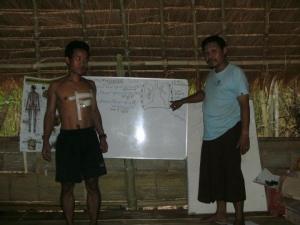
Saw Win Kyaw training War Casualities Management trainees in Nyaung Lay Bin District. (Photo: BPHWT)
Language barriers and computers: “All my experience is from the jungle”
Currently I take responsibility for the position of Director of Back Pack Health Worker Team.
In 2003 I became the BPHWT field in charge for Papun area and 2008-2009 they elected for the position of medical care program coordinator. I came here and just one year later the appointed me to the director position. I have been the director for four years now. The term lasts for another two years.
For me, one very difficult aspect is the language barrier, especially the English language. Before I worked in Papun area, I couldn’t speak Karen very well. Mostly I was using Burmese language. So when I arrived to Papun area I tried to learn and speak (Skaw) Karen because in my work I mostly communicate in Karen, with Karen people and in Karen language. After seven years I could speak (Skaw) Karen very well. My parents are Pwo Karen so I can also speak Pwo Karen. Not perfectly but I can speak and I can understand Pwo Karen. After seven years of working in Papun area I could speak Skaw Karen and I could communicate. But then they appointed me the medical health program coordinator and I came here. I had to start communicating with foreign people and also most letters I have to read are in English. So that is very difficult, the main difficulty for me.
The second thing is computer skills. All my experience is from the jungle. I never used a computer. Then I came here and I tried to type in English and Burmese and Karen. That was very difficult for me. That’s why I tried to learn English here and I tried to attend a short course in English lecture. Then last year, I applied for ACU [Australian Catholic University].
Joggling commitments: “I know myself, I need to learn”
Our lecturer and professor, Miss Maya, she selected the students for ACU. At the time we were at the entrance exam. She asked why you would like to attend and study in the ACU? I replied: Currently I take responsibility for the director position in Back Pack. I know that position is very important. I have to influence all organisations and I have to communicate with foreign persons. I need to explain to foreigners in English language. So I want to study at this school. I know and understand that your school is very good for learning English and at the same time also for other studies. So that’s why I came and I try to attend the school. I explained like that. She said that that is right. And then luckily they chose me.
Some people told me you are so stupid. Some people told me you are so crazy. At the time Maya my professor she said if you study in this school you have to take a lot of time so how can you manage your time, because you’re travelling a lot? Yes I am traveling a lot for field trips and I have to attend some meetings, trainings and seminars. Don’t worry for that because I will compromise with my team, I told her. Some parts I delegated to my staff. Every day I ran from here to ACU study centre. Sometimes I came back at midnight, and sometimes I went there for the whole Saturday and Sunday. I was very bad at reading and writing in English and also my typing was very slow.
I explained to my colleagues and I am very lucky that my colleagues understood me and I could delegate work to my staff. They were happy to try to do it. I also discussed with my wife. She also understood me. I am very lucky. Currently I have four children. Sometimes my boss, my top leader said you’re getting old, why do you study and attend school? No need. But I have nothing to reply to them. I know myself, I need to learn.
Old and new challenges: “Most donors are moving to Yangon”
In our current working areas in Kachin and Shan States they are still fighting a lot and there are a lot of offensives. Also in Palaung areas.
Another problem in the Karen State is land grabbing. So although the guns are not firing they do have a lot of land grabbing. The villagers in our Karen communities are so scared for the situation. It can also happen that they can go back to fighting again. I’m also very scared for that. We hope for the best in the future but one thing that can happen is going back to the conflict. I’m so scared for the Kachin and northern Shan State where they are fighting a lot and also because there is a lot of land grabbing. For our organisation I’m not so worried because now we have a lot of experience, we know how to help.
But currently, most donors are moving to Yangon. And we are most or all of the cross-border aid. So they have moved to Yangon and they are not taking care of the real vulnerable persons. The budget here is very very… much less and not enough for our estimated budget plan.
They should provide not only through Yangon but also cross-border aid. Our working areas are very remote areas and also most of our working areas are ethnic areas. So if the government or any NGO sends help through Yangon, they are very far away and then they also send their own staff there. One big barrier for that is lack of trust and common language. We have experience for more than ten years so we know how to deal with the communities and how to develop health programs in our areas. International donors should provide for the community based health system. Not directly come and provide their own system… The donors should understand that they need to continue to provide cross-border aid and also community based health activity.
This story is based on Saw Win Kyaw’s voice as he tells Burma Link about his life and experiences.
NEW! – Read more about the work of the Back Pack Health Worker Team and the recent challenges they have faced in the in-depth interview with Saw Win Kyaw.

